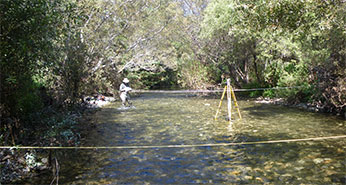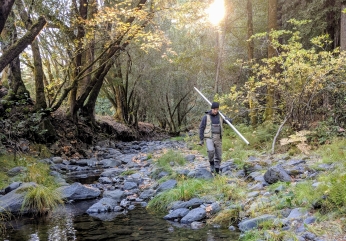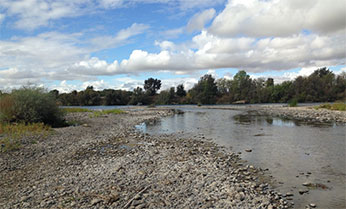Sound science is vital to the management of natural resources, especially when managing water. The CDFW Instream Flow Program (IFP) develops instream flows required to maintain healthy conditions for aquatic and riparian species. Instream flows are determined by investigating the relationships between flow and available stream habitat for waterways throughout California as required by the California Salmon Strategy (PDF), California Water Action Plan, Public Resources Code (§10000-10005) and FGC §5937 mandates. Scientifically defensible instream flow criteria can be developed through site-specific studies and/or functional flows, and may be transmitted to the State Water Resources Control Board (State Water Board) for consideration in water allocation and appropriation actions.
 Habitat survey transects in the Big Sur River.
Habitat survey transects in the Big Sur River.
 Scientist working at Mark West Creek.
Scientist working at Mark West Creek.
 Mill Creek by the Sacramento River confluence.
Mill Creek by the Sacramento River confluence.
To ensure high quality science that is robust, credible, transparent, and relevant, IFP conducts flow studies, collects field data, develops guidelines for quality assurance, conducts outreach, and coordinates with other agencies and interested parties on program related activities. The IFP coordinates study design, field data collection, and study implementation with CDFW Regional staff, State Water Board, U.S. Fish and Wildlife Service, and non-governmental organizations.
Instream flow studies should broadly consider the structure and function of the river system. Following the Instream Flow Incremental Methodology (IFIM), five riverine components (biology, hydrology, geomorphology, water quality and connectivity) are reviewed when developing instream flow criteria. The development of instream flow criteria provides information on important factors in streams, such as:
- Relationships of flow to aquatic habitat
- Aquatic habitat suitability
- Stream temperature
- Channel geomorphology
- Riparian habitat and restoration activities
- Temporal and spatial hydrologic characteristics of flow regimes
- Fish population abundance, distribution and dynamics
- Aquatic invertebrate production
What is Instream Flow?
Instream flow is used to identify the rate of water flow, measured in cubic feet per second (cfs), required at different times of the year at a specific location in a waterway. Instream flow criteria and implementation of these flows are required to protect aquatic habitat, sustain wildlife, provide recreational opportunities, and support agriculture and domestic uses. While some watersheds have flowing water throughout the year, it is often the responsibility of water managers to distribute the water between uses. CDFW, a natural resource management agency, is faced with the complex task of identifying and recommending instream flows necessary for supporting natural resources. Determining instream flows are crucial so that aquatic, riparian, and terrestrial resources dependent on water will be considered and protected during water distribution activities.
Instream Flow Program Documents
The Instream Flow Program is committed to developing publicly available guidance. Fact sheets, standard operating procedures, and quality assurance documents are all available under Instream Flow Program Documents.
For more information, contact instreamflow@wildlife.ca.gov.